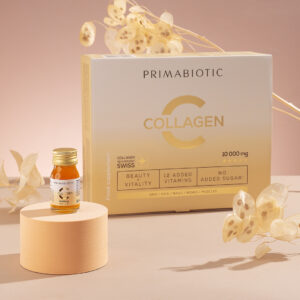In recent years, collagen broth – also known as collagen-rich bone broth – has grown in popularity as part of a healthy diet, particularly in the form of collagen broth for joints. This collagen-rich broth plays a key role in maintaining joint flexibility and supporting tissue regeneration processes, making it beneficial for individuals struggling with orthopedic issues. In this article, we’ll explore which meat is best for making collagen broth, provide a simple recipe, and consider the properties of collagen broth and whether collagen supplementation is necessary for our health.
Bone Broth for Joints: Natural Relief and Regeneration
Collagen broth also referred to as collagen-rich bone broth, has gained popularity as an important element of a healthy diet, especially in terms of joint support. Collagen, a key protein found in connective tissue, plays a fundamental role in the structure of cartilage, tendons, and ligaments. Regular consumption of collagen broth may bring various benefits, such as improved joint flexibility, reduced pain and stiffness, and support for tissue regeneration.
Collagen broth is rich in nutrients, including amino acids, minerals, and anti-inflammatory compounds, making it an excellent option for those with active lifestyles or those dealing with orthopedic problems. Its properties make it a valued addition to the diet, with the potential to support joint health and overall well-being.
Although collagen naturally occurs in the body, its production declines with age, which can lead to joint and skin problems. That’s why it’s worth enriching your diet with collagen-rich products such as collagen broth. This is a great way to provide the body with essential nutrients that support joint health. Preparing collagen broth at home is simple and allows you to control the quality of the ingredients – an important consideration for those focused on health. Not only does collagen broth support joint function, but it also improves skin condition, offering a range of health benefits. Regularly drinking collagen broth can therefore have many positive effects.
What’s the Best Meat for Collagen Bone Broth?
Choosing the right meat for collagen broth is essential, as the collagen content of the final dish depends largely on the cut of meat used. So, which meat is best for broth? The best choices are those rich in connective tissue, such as beef, veal, chicken, or turkey. Cuts from bones and joints – such as shank, ribs, or wings – are ideal, as they yield the highest collagen levels. Don’t forget marrow bones either, which are full of nutrients and enhance the broth’s flavour.
For poultry-based collagen broth, legs and wings are the best options due to their high connective tissue content. Chicken feet are also a great choice – they are packed with collagen and give the broth a unique texture. It’s important to use meat from organic sources, free from hormones and antibiotics. Such meat offers better nutritional value and improves the taste and quality of the final broth.
You can also add vegetables like carrots, onions, celery, and parsley root to enrich the flavour and aroma.
How to Make Bone Broth at Home
Making collagen broth is straightforward and doesn’t require advanced cooking skills. Below is a recipe for a delicious and nourishing broth. This type of collagen broth has fantastic properties, especially when made with chicken feet, which are particularly rich in collagen. You already know which meat to use – now for the recipe!
Ingredients:
- 2 kg marrow bones (e.g. shank, ribs)
- 1 kg poultry meat (e.g. chicken feet, wings, legs)
- 3 medium carrots
- 2 medium parsley roots
- 2 onions
- 1 celery stalk
- 2 garlic cloves
- 3 bay leaves
- A few allspice berries
- Salt and pepper to taste
- Water (3–4 litres)
Collagen Bone Broth Recipe
- Wash the bones and meat, then place them in a large pot. Cover with cold water (about 3–4 liters) and bring to a boil.
- Once boiling, reduce the heat and skim off the foam that appears on the surface.
- Add the chopped vegetables, garlic, bay leaves and allspice.
- Simmer on low heat for at least 4–6 hours (the longer, the better), topping up the water if needed.
- Once cooked, strain the broth through a sieve, then season with salt and pepper to taste.
- The broth can be served hot or stored in the fridge for a few days. It can also be frozen in portions.
This type of collagen broth is perfect as a soup base or a nourishing dish. Collagen has a beneficial impact on the skin, hair, and nails. Its presence in the body helps maintain firmness and hydration in the skin, which can slow down the aging process and improve elasticity. Hair becomes stronger and shinier, and nails less brittle.
By regularly drinking collagen broth, you can enjoy a tasty meal while also naturally supporting your health and appearance – an ideal choice for those who wish to care for their body from the inside using nature’s goodness.
Do You Need Extra Collagen If You Drink Bone Broth?
Collagen supplementation can particularly benefit individuals experiencing joint, skin, or hair problems. While collagen broth is a popular source of this protein, it’s worth noting that the amount of collagen obtained from broth may not be sufficient compared to the levels available in supplements. Hydrolysed collagen supplements are more easily absorbed by the body, making them a more effective option.
In addition, preparing broth can be time-consuming, and for some, it may be too rich or fatty. When choosing a supplement, it’s best to opt for products enriched with vitamin C and other ingredients that aid collagen absorption.
To sum up, the best results can be achieved by combining a healthy diet with collagen supplementation and regular consumption of collagen broth. This comprehensive approach not only supports natural collagen production in the body, but also contributes to healthy joint function, skin elasticity, and tissue regeneration.
See also other articles:
